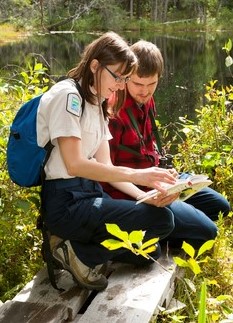Today’s post comes to us from Heather Stern, a naturalist at Bon Echo Provincial Park.
Many people visit parks each summer for vacation, relaxation, adventure, or more generally, a break from city life. These are all great reasons to get outside and enjoy nature.
However, while visitation to provincial parks is increasing, we want knowledge of the plants, animals, and the unique habitats that these parks protect to increase too.
Nothing to see here, folks!

Working at Bon Echo Provincial Park as a park naturalist, I have the pleasure of helping visitors learn more about what they are seeing in nature.
Initially, when I ask people what they have seen while exploring the park, often the response is “nothing.”
Now, while they may not have seen a charismatic mega-fauna like a deer or a moose, they are certainly still seeing something. The rocks, trees, and lakes found in provincial parks are often what attracts guests to visit in the first place!
Knowledge = increased enjoyment of nature
While knowing about the natural environment at your campsite or backyard is no longer necessary for survival, it can make time spent in nature far more enjoyable.

Rather than going for a walk through the woods and seeing a dense wall of unknown foliage, if you know how to identify those plants, you will see the mosaic of different species growing together in the dappled sunlight on the forest floor.
Picture the forest as a crowded room
Setting out into nature can be compared with going into a crowded room. When you know a few people in the room, it’s not as scary to mingle and chat with others. On the other hand, if you don’t know anyone, it can be extremely intimidating to go in and start getting to know people.

Similarly, if you head out into the woods, and you’re able to recognize even the most common plants and animals in the area, it feels a lot easier to investigate, and try to identify the species you don’t know.
Whereas, if you are not familiar with any of the species, investigating them one at a time might feel like a impossible task.
Gotta start somewhere!
Once you get started, and as your natural identification skills begin to progress, you’ll start to recognize more of the species around you.
I discovered this for myself back in the spring when I was trying to learn the different birds that live in the Bon Echo area.
Before I was able to distinguish a Black and White Warbler from a Black-capped Chickadee or a White-throated Sparrow from a Chipping Sparrow, all the little birds flying above me looked the same. But once I learned some key identifying features, my morning walks became far more interesting.

Suddenly, I was seeing dozens of different bird species, as opposed to the same few I thought I was seeing before.
Learning the names and characteristics of the different species around me has been just as important as the binoculars hanging around my neck in my pursuit of outdoor enjoyment.
So how can you build your identification skills?
 Start with the plants and animals in your backyard or neighbourhood.
Start with the plants and animals in your backyard or neighbourhood.
If you’re interested in birds, you could make a birdfeeder and try to identify the birds that come visit.
Once you are able to identify a few species, things start to become easier because you can compare any new species to the ones you already know. There are many apps, like iNaturalist, that can help you with your identification skills.
If you keep working at it, the next time you go for a walk in the woods, species you know will be as familiar as a friend in a crowded room. And this will help you gain a better understanding of the unique habitats we protect at Ontario Parks.
